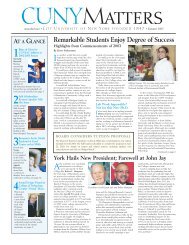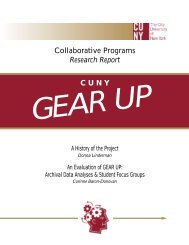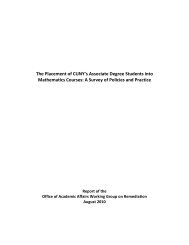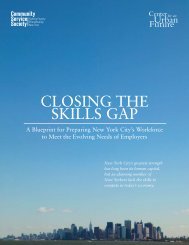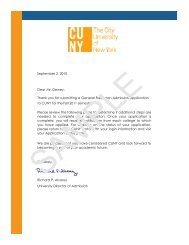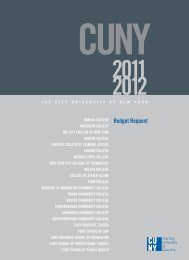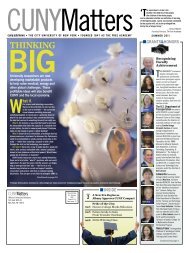CUNY Master Plan 2012-2016
CUNY Master Plan 2012-2016
CUNY Master Plan 2012-2016
You also want an ePaper? Increase the reach of your titles
YUMPU automatically turns print PDFs into web optimized ePapers that Google loves.
MISSION PART ONE<br />
one of the most important technical fields of the 21st century because it is essential to advances<br />
throughout society.”<br />
The IHPCC’s activities and capabilities continue to expand rapidly as its resources are integrated into<br />
research and courses across <strong>CUNY</strong>. With external funding, the computational capability has increased<br />
by more than a factor of 10 since the Center was initially established. Those resources are now oversubscribed.<br />
To accommodate the ever-expanding growth in usage, the computational capability of the Center<br />
will be doubled by September <strong>2012</strong>—a twentyfold increase in the past four years. We expect user<br />
requirements and the computational capability to expand again by a factor of 20 in the next four years<br />
as the Advanced Science Research Center and the Center for Urban Science and Progress develop. The<br />
IHPCC currently supports approximately 400 active researchers. This number is expected to increase<br />
to more than 1,200 by the end of the four-year planning cycle in <strong>2016</strong> when the IHPCC is relocated to<br />
the new Interdisciplinary High Performance Computing Building at the College of Staten Island.<br />
Contemporary computational research requirements in “Big Data” are driving a need for enhanced<br />
data storage, retrieval, dissemination, and archiving. This was clearly illustrated by the March 29, <strong>2012</strong>,<br />
White House announcement of a $200 million, multi-agency investment in the “Big Data Research and<br />
Development Initiative.” In recognition of “Big Data” needs, CSI, in a coordinated effort by the IHPCC<br />
with researchers from CCNY, Hunter, Baruch, and the Graduate Center, was awarded $1.3 million from<br />
NSF for a multi-petabyte data storage facility, which is scheduled for installation at the IHPCC in <strong>2012</strong><br />
and 2013. This facility will support researchers across <strong>CUNY</strong> in Environmental Sciences, Macromolecular<br />
Assemblies, Economics, Transportation Systems, Urban Analytics, Neuroscience, Phylogenetics, and<br />
other interdisciplinary research projects. We expect that the <strong>CUNY</strong> “Big Data” research requirements<br />
for data storage will increase by a factor of ten by the end of <strong>2016</strong>.<br />
The ASRC as well as <strong>CUNY</strong> research centers with “Big Data” requirements, particularly those in the<br />
Environmental Sciences, Economics, and Phylogenetics, require fast, high-capacity data transfer speeds<br />
between research equipment and the IHPCC for data storage and computational analysis. To accomplish<br />
this, CSI will spearhead collaboration through the IHPCC with CCNY and <strong>CUNY</strong> CIS, to establish a dedicated<br />
“Big Data” network prototype for optimal flow of scientific data, what is essentially a “Science<br />
DMZ.” This is a term coined by the Department of Energy for its ESnet, a concept that has since been<br />
adopted by NSF. The Science DMZ essentially removes large, bulk research data transfers from campus<br />
networks (thus relieving the burden on those networks) and puts them on point-to-point, dedicated,<br />
secure networks, optimized for high-speed flow of bulk data. The IHPCC will implement a Science DMZ<br />
for “Big Data” to support the ASRC and other <strong>CUNY</strong> research centers in this proposed <strong>Master</strong> <strong>Plan</strong>.<br />
In addition to the fast-paced research agenda, the IHPCC supports classes given at the Graduate Center,<br />
the College of Staten Island, Medgar Evers College, NYCCT, and Brooklyn College. We expect that<br />
the number of classes supported will grow substantially, and that every institution in the University will<br />
use the IHPCC in classes by the end of the next four years.<br />
25





